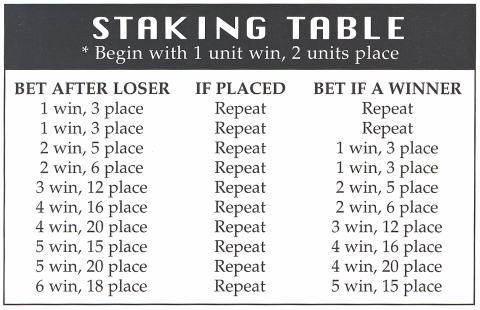Over the years, through dealings with hundreds of mad-keen punters, I've discovered that almost all are, at heart, conservatives. They are not risk-takers.
Give a man the choice between a 6/4 favourite and a 6/1 chance and he'll invariably go for the shorter priced runner. I'm not blaming him. Long-term, the 6/4 chance is going to win a lot more races than the 6/1, though with little chance of allowing the backer to emerge with a balance in the black.
This conservatism is why win and place betting remains so popular. Ordinary punters love to bet for a win ... but they are conservative enough to want to insure themselves against defeat by backing for the place as well.
Bearing all this in mind, the other day I decided to take a fresh look at a staking approach that we featured in PPM some 11 years ago. It's a win and place betting approach that should satisfy anyone craving for (a) insurance, (b) some excitement and (c) a staking plan that raises the temperature but not to boiling point.
Your opening investment is 1 unit to win (a unit can be any amount) and 2 units for the place. If the horse you have backed wins, then you repeat the bet. Once you bit a losing bet, you go to the next step (see the table below).

This table shows you simply how to operate the staking plan. Follow it exactly as outlined and you can't go wrong. This approach will not help you to win a fortune but it can be a very steady profit-taker, and it will help you regain losses through the rapidly rising place component.
Jon Hudson, writing back in 1987, said he recommended it for races in which there were 8 to 10 runners. You could consider, he said, operating two banks. One would be for all selections, the second for those races with 8 to 10 runners.
The table of staking shows the ratio of bets for a series of 10 selections. This should be ample to cover this form of betting. My recommendation is that you start a fresh series every time you get into profit. This makes the approach even safer.
You can work this method using the top selections of your favourite newspaper or formguide tipsters but the results can vary, as you will see from the workout I have produced here. On the stop-at-a profit basis, let's look at a few tipsters' performances on Derby Day at Flemington.
CRAIG YOUNG
Race 1: W1P2 Loss 3
Race 2: W1P3 Loss 4
Race 3: W1P3 Loss 4
Race 4: W2P5 WIN 24.85
Series ends
Bet 18, Return 31.85
PROFIT: 13.85
DARREN PRENDERGAST
Race 1: W1P2 Loss 3
Race 2: W1P3 Loss 4
Race 3: W1P3 Loss 4
Race 4: W2P5 Loss 7
Race 5: W2P6 WIN 3
Race 6: W2P6 Loss 8
Race 7: W3P12 Loss 15
Race 8: W4P16 Loss 20
Race 9: W4P20 Loss 24
Series ends for the day
Bet 93, Return 11
LOSS: 82
BRUCE SESSLE
Race 1: W1P2 Loss 3
Race 2: W1P3 WIN 7.55
Series ends
Bet 7, Return 11.55
PROFIT: 4.55
JOHN SCHELL
Race 1: W1P2 Loss 3
Race 2: W1P3 WIN 7.55
Series ends
Bet 7, Return 11.55
PROFIT: 4.55
ANDREW EDDY
Race 1: W1P2 Loss 3
Race 2: W1P3 Loss 4
Race 3: W1P3 WIN 35.90
Series ends
Bet 11, Return 39.90
PROFIT 28.90
MARK RYAN
Race 1: W1P2 Loss 3
Race 2: W1P3 Loss 4
Race 3: W1P3 Loss 4
Race 4: W2P5 Loss 7
Race 5: W2P6 WIN 35.20
Series ends
Bet 26, RETURN 43.20
PROFIT: 17.20.
In all instances except one, then, a profit was made, yet the warning is clear that if your tipster experiences a bad day, you could be in for a drubbing. So be warned that no matter what selection method you use, it will need to drag in winners and placers!
The placegetters will help to keep you out of trouble. If you back, say, four losers in a row, this would mean you outlaid 1-2, 1-3, 1-3 and 2-5, a total of 18 units. Your next bet would be 2-6. If you struck a placegetter at evens, then your return would be 12 for a profit of 4 on that bet, leaving you 14 in arrears.
Your next bet will again be 2-6 and if it won at $3 and $1.90 the place, the return would be 17.4 for a profit of 9.40, leaving you only 4.6 in arrears.
This, then, is a staking approach that while not without its faults, is one that can guarantee you some insurance if you can manage to strike placegetters while enduring a win-bet losing streak.
If you strike a good winner early, you can easily wrap up a series and leave the track for the day in profit. A good winner later in the day will invariably wipe out all losses.
By Mark Merrick
PRACTICAL PUNTING - DECEMBER 1998